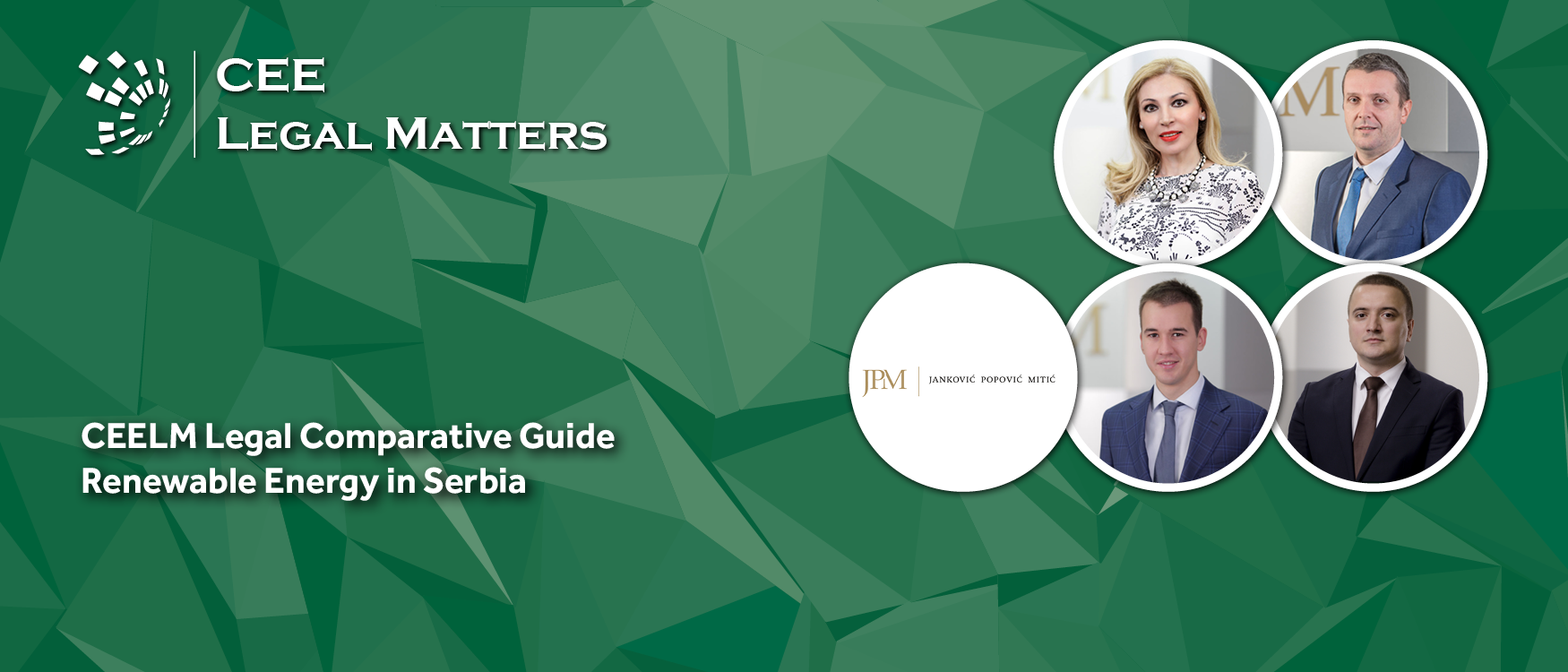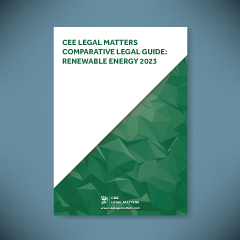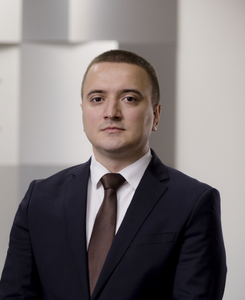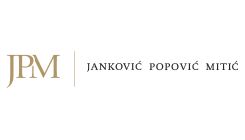Contributed by Jankovic Popovic Mitic
1. SUMMARY
Being a member of the Energy Community (EC) and with the commitment to its path of Euro-pean Union (EU) membership, the Republic of Serbia is devoted to harmonizing its legislation with the acquis communautaire of both the EU and EC, including the green transition. The ma-jor step in this respect has been the adoption of a new Law on the Use of Renewable Energy Sources in 2021 (Official gazette of the RS” no. 40/2021,” Law on RES), as well as several bylaws (e.g., Regulation on Market Premium and Feed-in Tariff, Regulation on Model of Agreement on Market Premium in 2021/2022). Previously, the renewable energy sector was scarcely regulated with only a few paragraphs of the Energy Law (Official gazette of the RS” no. 145/2014, 95/2018 – other law and 40/2021) and bylaws. Further development of the leg-islation is planned through the amendments of the Law on RES, which has been drafted at the end of 2022 and which has been subject to the public consultation that ended on 09 February 2023.
Before the adoption of the Law on RES, the major investments in the field of RES were made in wind power plants. The subject trend has been fostered by this law and extended to other types of RES power plants, such as solar power plants, biomass power plants, etc. Since the beginning of the application of the Law on RES, the transmission system operator faced a significant number of requests for connection to the grid for future RES power plants, precise-ly 14,000 megawatts hour power which greatly exceeds the current installed power of all power plants in the Republic of Serbia, being about 8000 megawatts hour.
Historically, the domestic market was mainly supplied with electric energy from thermopower plants. According to the latest available data published by the Energy Agency of the Republic of Serbia (AERS) in 2021, all types of power plants produced 35,656 gigawatts hour. The share of thermopower plants wasapproximately 60%, the share of RES power plants was ap-proximately 36% (out of which approximately 90% is old hydropower plants constructed by Elektroprivreda Srbije and the rest from other RES power plants), the share of combined thermo-thermal was approximately 1.5% while other power plants produced approximately 2.5%
RES projects are of high importance for the Ministry of Mining and Energy, which provides support for such projects, as well as the support provided through the Renewable Energy Sources Serbia association, which gathers investors. Moreover, the use of energy from the RES is defined as a matter of the public interest of the Republic of Serbia. In the course of the Law on RES, the state bodies are preparing the INTEGRATED NATIONAL ENERGY AND CLIMATE PLAN prof the Republic of Serbia for the period from 2021 until 2030 with a vision up to 2050, to achieve the main goals of the RES. Based on the preliminary targets, 49.6% of the RES in total power production should be achieved by 2040. The list of investors is ex-panding, and it is gathering reputable international companies in the RES sector, as well as an increasing number of experienced local players. International financial institutions and local banks are continuously supporting the development of RES projects in the Republic of Serbia. In parallel with this, local municipalities are providing subsidies to prosumers for the installation of roof solar power plants.
2. OVERVIEW OF THE COUNTRY’S RENEWABLE ENERGY SECTOR
2.1. Legal Framework
The Law on RES sets out the list of the power plants using RES as follows: hydro, biomass, biogas, wind, solar, geothermal, biodegradable waste, landfill gas power plants, as well as all other power plants using RES. Potential investors in any of the listed power plants may be entitled to the incentive’s measures. Please note that the power plants must be new or recon-structed to be eligible for incentives. Two types of monetary incentives are envisaged:
- Market premium, and
- Feed-in tariff.
Market Premium
Market premium represents the main incentive in the RES, by which the guaranteed supplier (Elektroprivreda Srbije – EPS) pays the market premium (determined in euro cents per kilo-watt hour) to the privileged producer in addition to the price for each sold kilowatt hour on the market.
An investor may be entitled to receive a market premium only after acquiring the status of a privileged producer. Such status is acquired through auctions. The Ministry of Mining and Energy (Ministry) organizes auctions, selects the best bids, and grants the status of a privi-leged producer. The auction is organized for a single type of RES power plant. To conduct the auction, the Government of the Republic of Serbia (Government), inter alia, must de-termine quotas for each RES power plant and the maximum amount of market premium that may be bided.
Currently, only for the wind power plants quota is determined at 400 megawatts hour, and the maximum amount of market premium is set out at 5.56 eurocents/kilowatt hour. The quo-tas and the maximum amounts of market premium for other RES power plants are still not determined.
The auctions consist of two phases, the bidding phase, and the selection phase. In the bid-ding phase, all interested parties submit their bids with the amount of market premium which satisfies them. In the selection phase, the Ministry ranks bids by the criteria – from the low-est to the highest, comparing to the maximum amount of market premium, until the quota is met.
The obligation of the Government was to adopt a regulation on balancing responsibility within 6 months from the adoption of the Law on RES, which deadline expired in October 2021. So far, the Ministry has not organized auctions given that the said regulation is not adopted yet. According to the Ministry announcements, adoption of the regulation may be expected in the upcoming months, following the amendments of the Law on RES. When the Government adopts this regulation, all legal requirements will be met and there will be no further obstacles to organizing the first auction for wind power plants.
Participants whose bids are selected will acquire the status of temporary privileged producer and then they are entitled to execute an agreement on market premium with the guaranteed supplier. The content of the agreement is regulated and cannot be amended without the consent of the Ministry.
Such status lasts two years, and within this period, a temporary privileged producer must draft an environmental impact assessment (if necessary, see Section 3.3.) and obtain a construction permit. Upon fulfilling these conditions, the validity period of a temporary privi-leged producer is extended for three more years, within which period the power plant must be constructed and the usage permit obtained. After that, the status of a privileged producer may be acquired.
The status of a temporary privileged producer may be extended for one year in two cases: (i) if the powerplant is fully constructed but a usage permit is not obtained and (ii) in case of force majeure.
When the power plant becomes operational and the privileged producer commences selling electric energy on the market, the market premium is activated but it works in two directions, as follows:
- If the selling price is lower than the allocated market premium, then the guaranteed sup-plier shall reimburse the difference to the privileged producer. In this manner is guaran-teed to the privileged producer that it will always collect the amount from its bid.
- If the selling price is higher than the amount of the market premium, the privileged pro-ducer is obliged to pay a positive difference to the guaranteed supplier (the difference between the selling price and the allocated market premium on the auctions).
The privileged producer is entitled to the market premium for a period of 15 years, starting from the first payment.
Feed-In Tariff
Feed-in tariff represents incentives through guaranteed purchased price per sold kilowatt hour. This incentive may be acquired only for small projects (up to 500 kilowatts hour, or in the case of wind power plants up to 3 megawatts hour) and demonstrative projects.
The procedure of acquiring the status of a privileged producer and the incentive period for a feed-in tariff is the same as for the market premium.
Additional Incentives
Apart from the above monetary incentives, the following incentives are prescribed:
- transfer of balancing responsibility; and
- access to the grid.
In respect of balancing responsibility, the Law on RES prescribes the balancing responsible party shall be a guaranteed supplier. The transfer of balancing responsibility from the privi-leged producer to the guaranteed supplier shall be regulated by the execution of an agree-ment on the transfer of balancing responsibility. As already mentioned, balancing is still pending to be regulated and it’s the only obstacle to initiating the first auction.
Furthermore, the operator of the transmission/distribution system is obliged to, with priority, allow delivery of the electric energy from the RES in their system. This obligation applicator all producers of electric energy from RES, the ones with the monetary incentive system, as well as the ones without.
Amendments of the Law on RES envisage that only electric energy from the power plants with installed power less than 400 kilowatts hour will have the right to deliver energy in the system with priority. This threshold will be decreased to 200 kilowatts hour starting from January 1, 2026.
Tariffs
The prices for access to the grid are regulated i.e., the Serbian regulator – the Energy Agency of the Republic of Serbia (AERS) – renders methodologies based on which the transmission/distribution system operator adopts its prices for access to the transmis-sion/distribution system. Those prices are subject to the approval of AERS and are pub-lished on its website. Currently, the price for access to the transmission system is RSD 59.3603 per kilowatts hour and the price for transmitting the electric energy through the sys-tem is RSD 0.4742 (higher tariff) i.e., RSD 0.2371 (lower tariff) per kilowatt hour.
Prosumers
One of the novelties introduced by the Law on RES is the concept of the prosumer. Now, both households and companies may install on its objects solar power plants, connect them to the grid, and consume the electric energy from their production. In case of overproduc-tion, prosumers may deliver the surplus to the grid and take it back when needed.
The households do not need any special requirements to obtain the status of the prosumer, just to install a solar power plant and submit a request to access the grid and execute an agreement with the grid operator. The companies, having in mind that their solar power plants are bigger, must go through a certain constructional procedure, but it is much simpli-fied than the construction of solar or other RES power plants for performing energy activity. For that reason, households and companies expressed a huge interest to become prosum-ers. According to the publicly available data, approximately 1,000 prosumers are registered so far in the register of prosumers.
Amendments of the Law on RES set out the limitation of 10 megawatts hour of installed pow-er for prosumers i.e., prosumers cannot construct solar power plants exceeding this threshold.
Trends in the RES field
Currently, a major part of the electric energy produced from the RES is generated in the hy-dropower plants and then wind power plants. So far, solar power plants and other power plants using RES participate in a minor part in the aggregate production of electric energy from RES.
Hydropower plants
The major player in the electric energy market in the Republic of Serbia is EPS which has the following hydropower plants: i) Djerdap which has 28 hydro aggregates with a total pow-er of 1,605 megawatts hour and an annual average production of 7,180 gigawatts hour, ii) Drinsko-Limske hydropower plants consist of 9 power plants with a total power of 1,390 megawatts hour and with an annual average production of 3,320 gigawatts hour and iii) mini hydro power plants with a total power of 21 megawatts hour and with an annual average production of 35 gigawatts.
In the following period, EPS is planning the construction of 2 hydropower plants i.e., the re-versible hydropower plants Bistrica and Djerdap 3, with the fact that Djerdap 3 will be a unique, hybrid power plant, which would include both solar and wind power plants.
Apart from the EPS, which is a 100% state-owned company, there were numerous investors in mini hydro power plants in the Republic of Serbia. However, due to the negative impact of mini hydro power plants on the environment and protests from the locals, the Law on RES prohibits the construction of mini hydropower plants in protected areas. Exceptionally, the Government may allow hydropower plant projects in a protected area, if they represent pro-jects of public interest.
Wind power plants
Currently, 9 wind power plants are operational with a total power of 533 megawatts hour, while the major ones are:
1. Cibuk 1 near Kovin with a total power of 158 megawatts hour, owned by Masdar;
2. Kovacica, near Kovacica with a total power of 104,5MW, owned by Enlight Renewa-ble Energy;
3. Kosava 1, near the City of Vrsac with a total power of 69 megawatts hour, owned by Fintel Energija;
4. Alibunar, near Alibunar with a total power of 42 megawatts hour, owned by Elicio.
The major ongoing wind power plants projects and plans are:
1. Fintel Energija plans to construct a wind power plant on the territory of the City of Su-botica with a total power of 599,2 megawatts hour, which will be the biggest wind power plant in the Republic of Serbia. Fintel Energija is also planning to construct To-rak, with a power of 120 megawatts hour, Kosava 2, with a power of 68,4 megawatts hour, Kula 2, 3, and 4 with a total power of 30 megawatts hour, Dunav 1 and 3 (20 megawatts hour) and Ram (10 megawatts hour).
2. Naftna Industrija Srbije and MET Renewables are together constructing the wind power plant Plandiste with a total power of 102 megawatts hour;
3. Elektroprivreda Srbija is constructing its first wind power plant Kostolac with the pow-er of 66 megawatts hour;
4. IEL OIE Balkan Renewable Energy is constructing the wind power plant Basaid in the vicinity of the City of Kikinda with a total power of 85 megawatts hour;
5. MK Group and ALFI Green Energy Fund are constructing the wind power plant Kri-vaca, in the vicinity of Golubac, with a power of 105.6 megawatts hour.
Additionally, currently in the territory of the City of Pancevo, 8 more projects with a total in-stalled power of 1.345 megawatts hour, are in different stages of obtaining spatial plans for constructing wind power plants.
Solar power plants
Unlike hydro and wind sources, so far solar energy is not much exploited. Currently, solar power plants in the Republic of Serbia have a total power of approximately 11 megawatts hour. Major projects in this field are:
1. DeLaSol is constructing a solar power plant with a total power of 9.91 megawatts hour, that should be operational as of March 2023;
2. Elektroprivreda Srbije is constructing solar power plant Petka with total power of 9,95 megawatts hour and planning to construct Srednje kostolacko ostrvo with total power of 97,2 megawatts hour;
3. Holding Slovenske Elektrane is constructing a solar power plant in Prapretno with a total power of 16 megawatts hour;
4. CWP plans to construct a solar power plant on Pester in the vicinity of Sjenica with a total power of 50 megawatts hour;
5. CMC Europe intends to construct a solar power plant in the vicinity of the City of Sombor with a total power of 100 megawatts hour;
6. UGT Renewables intends to construct a solar power plant with a total power of 1 gi-gawatt.
2.2. Domestic Sales and Imports/Exports
According to the Energy Balance of the Republic of Serbia for 2023, in the structure of the planned total domestic production of primary energy (both electric and thermal energy) for 2023, RES participate with 26%, while the estimated value for 2022 was 25%. In 2023, it is planned to increase the production of primary energy from wind, biogas, and hydro potential compared to 2022 by 7%. The planned import (with transit) of electric energy in 2023 is 23% less in comparison to estimated imports in 2022, while the planned export (with transit) of electric energy in 2023 is 39% more than of estimated exports in 2022.
The increase in the production of energy from RES demands investment in the power grid. According to a recent press release from the Ministry, the Government plans to invest EUR 10 billion in the country’s power grid over the next twenty-five years to support the growing demand for new renewable energy capacities.
In the next period, the Republic of Serbia will adopt new the Integrated National Energy and Climate Plan of the Republic of Serbia for the period from 2021 until 2030 with a vision up to 2050, by which is expected to be presented new targets for RES i.e., the share of 40% in total energy production.
EMS AD Belgrade (EMS), as the only transmission system operator in the Republic of Serbia, adopted the Transmission System Development Plan of the Republic of Serbia for the period from 2020 to 2029. Pursuant to this plan, the improvement of the transmission grid from 200 kilovolts to 400 kilovolts in Western and Central Serbia (known as a part of the Transbalkan Corridor), as well as interconnections with neighboring countries (Montenegro and Bosnia and Herzegovina), are a pillar of development in the next 20 years. Additionally, numerous devel-opments of local projects are envisaged.
On the European level, the European Network of Transmission System Operators for Elec-tricity (ENTSO-e) currently prepares a Ten-Year Network Development Plan which envisag-es the construction of 5 interconnection projects in the Republic of Serbia: (i) Trans-Balkan Corridor, (ii) Interconnection line between Serbia and Croatia, (iii) Pannonian Corridor, (iv) North CSE Corridor, and (v) Central Balkan Corridor.
2.3. Foreign Investment and Participation
The Republic of Serbia does not impose restrictions on foreign companies in relation to acqui-sitions of interest in the Serbian energy sector.
Apart from the said, the Law on Investments of the Republic of Serbia (Official gazette of the RS” no. 89/2015 and 95/2018) lists benefits to foreign investors, such as the right to transfer profit, protection from expropriation, or similar acts, stability clause, national treatment, etc. However, the Decree on Determining the Criteria for Awarding Incentives to Attract Direct In-vestments (“Official Gazette of RS”, no. 1/2019) provides that incentive funds for foreign in-vestors cannot be allocated for the implementation of projects in the energy sector, to prevent double incentive system for a single sector.
For additional information please see Section 3.2.
2.4. Protection of Investment
The most important treaties in the energy sector are:
- the Treaty establishing the Energy Community, which the Republic of Serbia be-come party to in 2006. Pursuant to this Treaty and decisions of the EC bodies, the Republic of Serbia has concrete obligations to improve energy efficiency and the environmental situation related to network energy and to develop RES. The Republic of Serbia has a duty to implement acquis communautaire and the principles and tar-gets in the RES fields adopted by the EC;
- the Stabilization and Association Agreement, entered into force on September 1, 2013, granting the Republic of Serbia the status of an associated country to the EU, by which agreement the Republic of Serbia, inter alia, undertook the obligation to be as much as possible harmonized with EU energy sector. In the end, the 2021 Re-public of Serbia has fulfilled initial requirements in the energy sector and therefore has opened an energy chapter in negotiation with the EU;
- the Paris Climate Accord or The Paris Agreement is an international treaty on climate change adopted in 2015, which covers climate change mitiga-tion, adaptation, and finance. The Republic of Serbia is one of the 195 countries which signs this Agreement.
- The Sofia Declaration On The Green Agenda For The Western Balkans was adopt-ed on November 10, 2020, by the leaders of the Western Balkans, at the WB Sum-mit under the framework of the Berlin Process initiative. This Declaration follows the main principles and goals of the European Green Deal; and
- the Agreement on the Implementation of the Project “Promotion of RES and energy efficiency in Serbia”, executed between the Republic of Serbia and the German international coopera-tion agency GIZ – Deutsche Gesellschaft fuer Internationale Zusammenarbeit, on June 28, 2022, with the value of EUR 1.5 million.
Additionally, the Republic of Serbia executed numerous agreements on mutual incentives and investment protection, with over twenty such agreements with EU countries (inter alia United Kingdom, Germany, France, the Netherlands, etc.). The majority of the agreements are executed for a period of ten years with an automatic extension for the same period or an indefinite period.
3. DEVELOPMENT OF RENEWABLE ENERGY PROJECTS
3.1. Granting of Grid Connection Rights
Pursuant to the Energy Law, producers of electric energy from RES have the right to access the grid. To exercise this right, producers must initiate an administrative procedure with the transmission/distribution system operator, in line with the Regulation on Conditions for Deliv-ery and Supply of the Electric Energy (“Official Gazette of the RS” no. 63/2013 and 91/2018) and provisions of network code of the relevant system operator from which the producer is requesting connection to the grid. The connection request is submitted to the transmis-sion/distribution system operator only upon obtaining a construction permit for the RES power plant.
If all conditions from the Regulation on Conditions for Delivery and Supply of the Electric Energy and network code of the relevant system operator are met, a system operator shall is-sue approval with the validity period corresponding to the necessary time for the construction of a power plant.
In addition to the connection to the grid, when the power plant is operational, it must have ac-cess to the grid. This means that the producer is obliged to submit a request for access to the system and upon approval execute an agreement on access to the system with the system operator to which the grid is connected. The connection to the grid means just a technical connection between two energy objects. Granting access to the grid means that a producer has capacity in the grid and may deliver electric energy.
The prices for access to the grid are regulated (see Section 2.1.).
In case the system operator rejects to give its approval for connection or access to the grid, the producer is entitled to file an appeal to the AERS.
3.2. Ownership by Foreign Companies
Serbian laws do not envisage any obstacles for a foreign investor to incorporate a company in the Republic of Serbia and to conduct any energy activity, including the production of elec-tric energy. In this respect, no authorizations or special approvals are required.
The same applies to buying shares in a company that is licensed for the production of electric energy. If the foreign investor wants to sell its shares in a domestic company performing en-ergy activity, it may do it freely. The only limitation is that foreign investors are not allowed to directly conduct energy activity, but through domestic companies, except for energy activity of wholesale supply of electric energy, which a foreign investor may perform.
Additionally, the Law on PPPs and Concessions, as well as Energy Law, provides the r pos-sibility for public-private partnership and concession projects in the energy sector, which en-compasses the construction of power plants and performing energy activity production of electric energy. Nevertheless, in practice, energy projects are not principally implemented through public-private partnerships and concessions. However, several communal PPP pro-jects included the production of energy from RES as an auxiliary activity to the main subject of the PPP.
3.3. Stages of the Development Process
The process of developing RES power plant from the very beginning (preparatory actions for fulfilling all mandatory conditions for the construction of the power plant) up to obtaining a license for energy activity, commencing production of electric energy from RES, and acquiring the status of privileged power producer may be divided into several steps.
Land
The first step in the process is choosing a suitable location to build the RES power plant. One of the novelties in the Law on Spatial Planning and Construction in favor of potential investors is the possibility to construct RES power plants directly on agricultural land, without the need to change the purpose of the land from agricultural to constructional. Furthermore, no special approval to build the RES power plant on agricultural land is envisaged. Having in mind that in the Republic of Serbia, wind and solar power plants are mainly constructed in the agricultural parts of the country, such a possibility facilitates the first step in the process. However, the investor must obtain either ownership right over the land parcel/s or execute a lease agree-ment with the owner of the land parcel/s to be eligible to obtain further necessary permits.
Energy permit
Upon choosing the land for the power plant, and before obtaining the construction permit, an investor is obliged to obtain an energy permit for the future RES power plant. The Ministry is the competent state body authorized to issue energy permits upon the request of an investor. The energy permit is valid for three years and may be extended upon request of the holder but it is not transferrable.
In case an investor intends to construct a power plant with installed power up to 1 megawatt hour, it is relieved from this obligation. The same applies if the power plant is built through a private-public partnership or a concession.
Participation in auctions for RES incentives
At this point and if the Ministry publishes auctions for the type of power plant that an investor intends to build, an investor through the domestic company – a future producer of electric en-ergy, may participate in the auction for market premium (or feed-in tariffs). To be qualified for the first phase in the auction, a company must obtain, besides an energy permit, location conditions, and confirmation from the transmission/distribution system operator that the RES power plant may be connected to the grid.
Additionally, a company is obliged to provide to the Ministry security for the seriousness of the bid in the form of either (i) a bank guarantee or (ii) a deposit. The amount of security is 30 EUR per requested kilowatts hour, regardless of the form.
If a bid is accepted, a company may acquire the status of temporary privileged power pro-ducer (see Section 2.1.). Please note that this status may be acquired only if the power plant is not under construction.
Environmental Impact Assessment and Construction Permit
Pursuant to Serbian laws, for the construction of power plants with installed power equal to or exceeding 50 megawatts hour conducting the environmental impact assessment is mandato-ry.
On the other hand, for the construction of power plants with installed power between 1 mega-watt hour and 50 megawatts hour (and for wind power plants between 10 megawatts hour and 50 megawatts hour), the competent state body shall decide on the need to conduct an environmental impact assessment upon request of an investor. If environmental impact as-sessment is not mandatory, the competent state body shall issue a confirmation in this re-spect.
When applying for a construction permit, it is necessary to submit to the competent state body an energy permit and environmental impact assessment (if those documents are man-datory to obtain).
Usage Permit and Energy License
Upon obtaining a construction permit for the RES power plant, the investor may initiate a pro-cedure before the transmission/distribution system operator to connect its power plant to the grid (see Section 3.1.).
A final step in the construction of the power plant is a usage permit. This permit is issued upon an investor’s request within the deadline of five working days. Pursuant to the Law on Spatial Planning and Construction, if the competent body fails to issue a usage permit (although all conditions from this law are met) within the prescribed deadline, an investor is authorized by the law to use a power plant.
Having in mind that the Energy Law considers the production of electric energy as an energy activity for which the energy license is needed, at this point, an investor is obliged to initiate a procedure for obtaining an energy license (see Section 4.3.).
When all the above steps are taken, an investor is authorized to commence energy activity of the production of electric energy. However, at this point, an investor, pursuant to the Law on RES improves its status from temporary privileged producer to privileged producer and is en-titled to receive a market premium (or feed-in tariffs) as an incentive.
3.4. Obligatory State/Public Participation
Pursuant to Serbian laws, private investors may freely incorporate companies in the Republic of Serbia, and perform energy activities, without state participation in form of either ownership or management of the company.
However, all energy entities are obliged to comply with the law and are under the scope of competence of AERS. Specifically, producers of electric energy are obliged to submit to the AERS data relevant to the supervision of the electric energy market as well as to keep rec-ords on production data in the power plant for a period of five years and to deliver it to the AERS upon request.
3.5. Risks to be Considered
The major risk in the RES sector is two direction market premia, meaning that if a privileged producer sells electric energy above the price allocated to it on the auctions, the privileged producer will be obliged to pay the positive difference (difference between market price and allocated market premium on auctions) to the guaranteed supplier, and has no right to keep the extra profit (see Section 2.1.).
Additionally, EPS, as the guaranteed supplier, for a long-time has had a problem with liquidity, as a result of, inter alia, low electric energy prices for guaranteed supply, resulting in delays in the payment for electric energy received from producers of the RES. From the perspective of current experience, the RES power plants, especially mini hydropower plants may incite the protest from locals at the construction sites.
4. RENEWABLE ENERGY CONSTRUCTION AND PRODUCTION
4.1. RTB Status
Plan of Detailed Regulation
As explained in Section 3.3., the first step is choosing a location in which the future RES pow-er plant will be constructed. In this regard, it is necessary to obtain from the local municipality a regulation plan of the subject area to determine whether a chosen location is already deter-mined for the power plant. If not, which is usually the case, first a local authority must adopt a new plan of detailed regulation of the subject area to include the power plant.
Location Conditions and Water Conditions
The next step is obtaining confirmation from the transmission/distribution system operator on the technical possibility to connect the future power plant to the grid. Simultaneously, an in-vestor obtains location conditions, which encompasses all necessary data for drafting the technical documentation for a construction permit.
If the future power plant will have an impact on the waters, an investor must obtain water con-ditions that contain technical conditions for the construction of the power plant. In practice, for the RES power plants water conditions are relevant for the hydropower plants and other pow-er plants if the transmission line connecting the power plant and grid needs to be constructed over water.
Environmental Impact Assessment and Energy Permit
Please see Section 3.3.
Consent to the Technical Documentation
Upon drafting the technical documentation and project for the construction permit, which is based on the above documents, such a project needs to go through technical inspection. On-ly after a positive outcome of the inspection, an investor may apply for a construction permit. If water conditions are issued, an investor must also obtain water consent.
Construction Permit and Notice of Commencement of Works
For the construction permit please see Section 3.3. Additionally, to start performing construc-tion works, an investor is obliged to submit a notice of commencement of works to the com-petent state body. After this step, everything is set for placing the foundation stone of the fu-ture power plant.
4.2. Construction of Renewable Energy Projects
Please see Sections 3.3. and 4.1.
4.3. Granting of Renewable Energy Production Licenses
Pursuant to the Energy Law, the production of electric energy is considered an energy activi-ty for which the energy license is needed.
An energy license may be issued only to the domestic company (save for the license for the wholesale supply of electric energy which may be issued to the foreign entity). AERS is the competent body for the issuance of a license upon the request of the producer of electric en-ergy if all criteria from Energy Law and relevant bylaw are met by the applicant. The energy license for the production of electric energy is valid for 30 years and may be extended upon request of the energy entity.
An energy license is not needed for power plants with an installed power of less than 1 meg-awatt hour.
4.4. Renewable Energy Production by Foreign Investors
Please see Section 3.2.
4.5. Operation and Maintenance of Renewable Energy Projects
It is worth noting that the producers of the electric energy from the RES are entitled to sell electric energy on the market without a license. However, only in the case of a supply of final consumers (natural and legal persons who buy electric energy for their consumption), the license for supply is mandatory.
No other specific regulations on the operation and maintenance of renewable energy pro-jects are in force in the Republic of Serbia.
4.6. Decommissioning Process
Pursuant to the Law on RES, the privileged producer of electric energy must dismantle and remove the power plant after its lifespan and conduct sanitation of the land where the power plant used to be.
As a security that this obligation will be fulfilled, the privileged producers are obliged to deposit, on a monthly level, a certain amount in the special bank account of the Ministry. If a privileged producer fails to remove the power plant and conduct sanitation, the costs of those actions shall be covered by the deposited funds.
4.7. Risks to be Considered
Please see Section 3.5.
5. BALANCING OF RENEWABLE ENERGY PROJECTS, STORAGE, SALES
5.1. Balancing of Renewable Energy Projects
According to the Law on RES, the guaranteed supplier is obliged to take the balance respon-sibility from the RES producers.
This applies to the ones who are in the market premium system or are outside the incentive system, until the establishment of an organized liquid within-day electricity market. Also, the guaranteed supplier assumes the balance responsibility and bears the balancing costs for the RES producers who are in the system of feed-in tariffs, and until the expiration of the incentive period.
Proposed amendments of the Law on RES
The amendments of the Law on RES prescribe that the guaranteed supplier assumes balanc-ing responsibility for users of the market premium, but such users are obliged to pay to the guaranteed supplier (i) a certain percentage from the allocated market premium per each produced megawatt hour, and (ii) positive difference between sold and produced electric en-ergy, calculated based on the price on the day ahead market.
The guaranteed supplier shall be still the balancing responsible party for the feed-in users, but now other RES producers are excluded i.e., they will be responsible for balancing instead of the guaranteed supplier.
5.2. Storage
Electric energy storage is introduced in the energy system of the Republic of Serbia by the latest amendments to the Energy Law. For this energy activity energy license is not required.
Pursuant to the Energy Law, an energy entity performing the activity of electric energy stor-age may, inter alia, provide storage services to the others market participants and buy and sell electric energy.
Additionally, the Law on RES prescribes that the prosumer has the right to store electric en-ergy independently for their own needs. Although stipulated by the Law on RES, so far there are no such energy entities in the Republic of Serbia.
5.3. Sales
Producers from RES may freely sell electric energy on the market and may execute bilateral power purchase agreements. Those agreements, apart from the general clauses from the Law on Torts and Contracts, must contain, inter alia, supply dynamics, method of calculation and terms of payment for the purchased electric energy, the method of informing the custom-er about changes in prices, and other conditions of electric energy supply, method of resolv-ing disputes. Market participants may use the models of power purchase agreements provid-ed that such agreements contain all specific mandatory clauses. For more information, please see Section 4.5.
6. ROOFTOP, OFFSHORE, FLOATING, AND AGRICULTURAL RENEWABLE EN-ERGY PROJECTS
6.1. Offshore Wind and Floating Photovoltaic Projects
There are no such projects, as the Republic of Serbia is a landlocked country. Having this in mind, our legislation does not recognize these types of projects, only onshore wind and solar projects.
6.2. Rooftop Photovoltaic Projects
Solar energy projects are the project with the biggest increment in the last few months, espe-cially bearing in mind that Law on RES prescribes that the households and the industry are enabled to become prosumers. Households and industry are, thus, able to install solar power plants on their buildings and use the produced energy for their consumption, while storing the surplus or delivering it to the system, or leasing their rooftop capacities to the RES producers of electric energy. In particular, the investors have been expressing interest in leasing the rooftop of shopping malls to build solar power plants.
6.3. Agrivoltaic Projects
The concept of agrivoltaics, combining the agricultural use of land with the production of elec-tric energy by photovoltaics is starting to develop in the countries from the SEE region, with various projects at different stages of implementation. The Law on RES does not explicitly prescribe differences between the types of solar projects, so there are no special rules for agrovoltaic projects compared to solar projects.
7. TRADING OF GREEN CERTIFICATES/CERTIFICATES OF ORIGIN
7.1. Certification
According to the Law on RES, a producer of electric energy from the RES who is not in the monetary incentive system is entitled to certificates of origin.
The certificate of origin is issued by the EMS in the following manner – one certificate of origin for every megawatt hour of electric energy produced.
The certificate of origin shall be valid for one year from the last day of the period of production for which it is issued and shall cease to be valid after its utilization, withdrawal, or expiry of a period of one year.
When issued in other countries, the certificates of origin shall also be valid in the Republic of Serbia under the conditions of reciprocity in accordance with ratified international treaties.
The transmission system operator is obliged to keep a register of certificates of origin (and those issued abroad) in electronic form and publish data from the register on its website.
7.2. Trading
Currently, the trading of certificates of origin is regulated with a bylaw adopted in 2017 based on the Energy Law and before the Law on RES and will be in force until new regulation is adopted. Pursuant to the applicable rules, the certificate of origin may be transferred only be-tween energy entities registered with the transmission system operator as well as between the registered domestic energy entity with the foreign energy entity registered in the relevant register.







